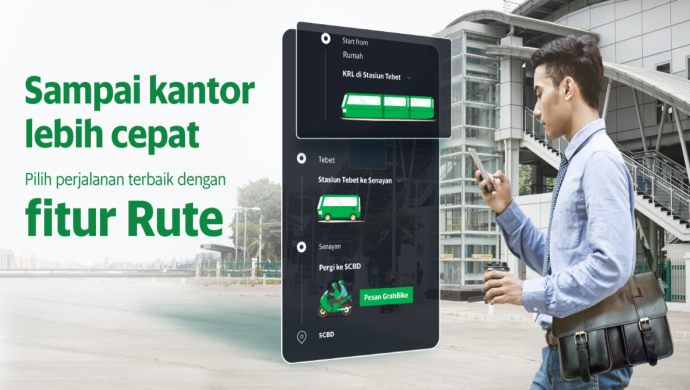Starting with Indonesia, the integration will see public transportation options available on the app with Trip Planner feature

Grab announced today that it officially operates mass market transportation services with public transit integration onto its app in Southeast Asia, starting with Jabodetabek area in Indonesia since three weeks ago. Grab offers first-mile-last-mile trips through a new Trip Planner (“Rute” in Indonesian) feature.
Grab also connects GrabBike and GrabCar to its first-mile-last-mile trips to and from public transit stations or bus stops in order to complement the public transportation options.
The Trip Planner feature will continue rolling out in other Southeast Asian cities in the coming weeks, along with its bus travel marketplace.
Leveraging its partnership with cities, public transit agencies and private companies, the new public transit and bus offerings cater to mass market consumers and provide access to transportation services that are affordable enough for everyday use. The two new features will offer mass transit options that are up to 70 per cent cheaper than private-hire car-hailing services.
“Today, in Jakarta for example, more than 70 per cent of daily trips are taken on motorcycles and private cars rather than public transportation when commuting to and from city centres. These trends underpin the massive congestion problems plaguing the city. Our long term vision is to make people ’s everyday commute so reliable and seamless that they eventually choose to leave their vehicles at home. Mass transit – via buses, shuttles or high-quality public transport – is the only way to achieve this without adding cars to the roads,” said Ngiam Xinwei, Head of Marketplace and Shared Mobility of Grab.
Also Read: Student housing startup Oxfordcaps secures US$8.15M led by Times Internet
Trip Planner feature enables users to plan their journey with accurate public transportation information and end-to-end directions within the Grab app. Grab also seized the new MRT Jakarta launch momentum to introduce this feature and collaborated with MRT Jakarta to integrate its public transit information into the Grab app.
Grab said it will also provide shelters for pick-ups and drop-offs near the stations to better serve users’ first-mile-last-mile needs and ensure the safety of driver-partners and passengers.
“Through the integration of real-time transit schedules on the Grab platform, we believe that we can increase our ridership by tapping into the wide user base of Grab. More people will have better visibility, predictability, and reliability of when the next train will arrive and plan in advance,” said William Sabandar, President Director, MRT Jakarta.
Besides the new MRT lines, the Grab app will also display live public transit schedules from commuter rail, Airport Rail Link, Transjakarta public bus services, as well as more than 50 fixed schedules of public buses across Jabodetabek.
Simply by entering a current location and destination via Trip Planner, commuters are able to view available public transit routes nearby that will get them to their destination, along with real-time departure and arrival times for some of the public transport services. They will also receive walking directions or recommendations of first-mile-last-mile transportation options such as GrabBike or GrabCar to and from public transit that they can book right away.
Furthermore, not only public transit partners will get increased ridership, access to Grab’s network of ride-sharing services, and journey planning, they will also get to understand how commuters use public transportation services in-app and identify any gaps in existing public services that need to be plugged to improve accessibility for all.
As for “Bus” feature, Grab will pilot the marketplace over the next few months across key Southeast Asian cities. Grab will allow users to pre-book a seat at a price point lower than ride-hailing services, on a route provided by Grab’s bus partners, eliminating queuing and bridge the transit gap for people living in underserved areas where getting to and from city centres remains a hassle.
Also Read: Government-backed blockchain accelerator Tribe adds BMW, Intel, Nielsen as partners
Bus operators will be able to efficiently manage and operate their bus fleet by getting full visibility of user demand information in advance. They can better allocate their available supply, and unlock new opportunities to serve unmet transportation demand.
“Ultimately, the mass mobility ecosystem we want to build is one that allows anyone to plan their trip end-to-end, book, buy electronic tickets, and pay for their entire journey across all modes of transportation, public or private, through one integrated payment system, while reaping the benefits of GrabRewards loyalty programme simply by going about their daily commute,” Ngiam added.
–
Image Credit: Grab
The post Ride-hailing behemoth Grab now serves mass public transportation in Southeast Asia appeared first on e27.